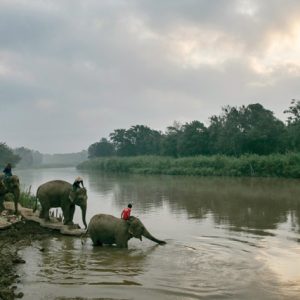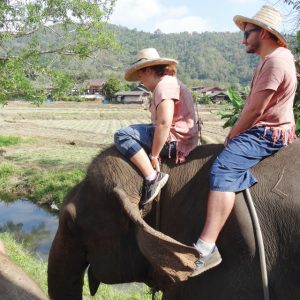Bruised behinds and ignored instructions are in plentiful supply on a one-day elephant-handler excursion in Chiang Mai
The elephant looms large in Thai history and culture. Signs of its omnipotence are everywhere. The symbol of the Bangkok Metropolitan Administration depicts the Hindu god Indra astride his elephant, named Erawan. Outside Thai universities lie shrines to Ganesha, the elephant-headed god of knowledge. The old flag of Siam, featuring a sacred white elephant, still adorns certain museums and photographic archives.

While elephant rides have long been an itinerary-filler in the Kingdom, in recent years a number of camps have opened in the north of Thailand where visitors can train to be a mahout – an elephant handler – for a day, a week or more.
One such facility is the Ran-Tong Save and Rescue Elephant Centre, which claims to have rescued eight of its elephants from the streets of Bangkok. It doesn’t keep its charges chained up or put on any circus-style shows either, which are encouraging signs that the animals are treated well.
Our half-day programme started with an early morning pickup and an hour’s drive out of Chiang Mai city to the green highlands of Mae Taeng. Elephants are perfectly adapted to these undulating regions, even serving as the taxis and trains of a century ago, when a journey from Bangkok to Chiang Mai could take a month or more.
The camp sits at the bottom of a verdant valley, where we were first introduced to the elephants in an outdoor area ringed by wooden buildings where we fed them bananas and sugarcane before donning straw hats and rough-hewn cotton shirts.
During the initial briefing session, the lead mahout quickly shot down any high-flying pretensions of attaining much expertise as an elephant handler in a single day. He flashed a chalkboard displaying the Thai words for the six main commands: melong (lie down); hao (stop); khwa (turn right); sai (turn left); toy (reverse); pai (go). “Don’t worry,” he said, laughing. “The elephants won’t listen to you anyway.”
It was soon time to meet our elephants for the day. My ride, named Mae Baer, was a small female aged five or six. All the other creatures that would serve as our mounts and mentors were females too: a safety precaution because males are simply too unpredictable to ever fully tame. When they go into musth during the rutting season, they defy the gentle giant stereotype and become extremely dangerous. Last year, a bull elephant terrorised a series of automobile drivers in Thailand’s Khao Yai National Park by charging at and damaging their vehicles.
For those at the tamer end of the scale there are three main ways of getting on an elephant, thereby multiplying one’s chances of looking awkward and foolhardy. The most difficult methods are either being lifted up by its trunk and scrambling over its head or climbing up a leg that it extends to give you a boost. Most of us chose the easiest option: waiting for the real mahout to make the beast squat down and then clambering up onto its back.
To ride one of these jumbos, the mahout sits behind its ears, holding on to what looks and feels like a length of garden hose wrapped around its neck. This is a precarious position. Each time the creature dips its skull, cratered with bumps and indentations and carpeted in spiny black hair, the mahout has to grip on to the hose tightly and veer back so as not to take a tumble.
Within 10 minutes the lead guide’s prophecy had come true. The world’s largest living land animal ignored all of our repeated instructions. We were not driving them so much as they were following their gut instincts, frequently stopping to forage as they ambled along the path.

For the most part, it was more of a comedy caper than a wildlife thriller, although at one point one of the bigger beasts, carrying a Western couple, veered off the dirt path and into a rattling clump of bamboo to start chewing the leaves, leaving them with a few scratches after a keen flogging by the branches. Soon a mahout stepped in to help them out of harm’s way. Of course, the animal listened to his commands.
The final leg of training day involved bathing the elephants in a pool; they returned the favour by using their trunks as shower hoses. Afterwards, still dripping water, the most daring newbie in our group attempted to mount her charge by letting the animal lift her up with its trunk. Beaming throughout, she scrambled up and over its head to assume the seat of honour atop its neck – a feat of proboscidean gymnastics that proved some rookies can make it to the next level of training.
With the fantasy of becoming skilled elephant handlers well and truly extinct, it was time for some reality checks about this endangered species. During the final briefing our guide told us that there are now just 7,000 elephants left in Thailand, down from 100,000 a century ago.
Adam Oswell, the founder and director of the Wildlife 1 Conservancy based in Chiang Mai, agrees. In 2012 he carried out a comprehensive survey of elephant camps and zoos in Thailand for the wildlife trade monitoring network Traffic, counting some 5,043 individuals.
Asked about the creature’s future in Thailand, Oswell said: “It’s pretty grim because of the loss of habitat and being poached for their tusks. These days conservation work is all about protection, limiting the damage. So the only viable option for elephants in captivity is tourism.”
For an animal that once carried kings and appeared on the national flag, it’s a mighty big fall from grace. But at least it beats extinction.
Keep reading:
“Mountain high: Cambodia’s Cardamom Mountains” – A journey through the great wilderness that is Cambodia’s unspoilt Cardamom Mountains provides a challenging itinerary for seasoned adventurers and tenacious beginners alike


